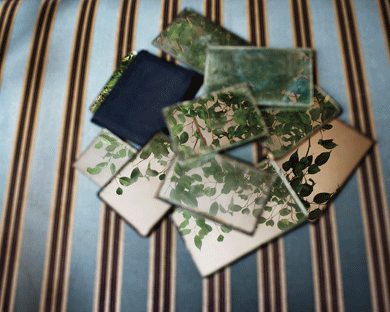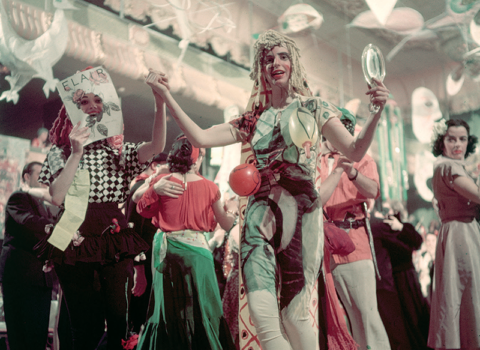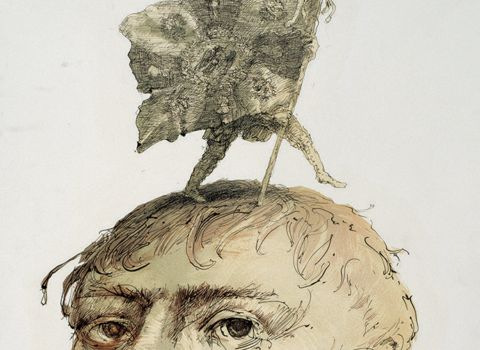THE VEGETARIAN (Hogarth, $21) is the first — there will be more, let’s hope — of Han Kang’s novels to arrive in the United States. Published in South Korea in 2007, the story concerns a young woman named Yeong-hye, who renounces meat for an all-plant diet and ends by resolving to become a plant herself. The style is realistic and psychological, and denies us the comfort that might be wrung from a fairy tale or a myth of metamorphosis. We all like to read about girls swapping their fish tails for legs or their unwrinkled arms for branches, but — at the risk of stating the obvious — a person cannot become a potted bit of green foodstuff. That Yeong-hye seems not to know this makes her dangerous, and doomed.
Then again, people have always hated what they don’t understand. Yeong-hye’s husband, Mr. Cheong, a mediocre, conventional businessman who narrates the first section of the novel, is angry at his wife’s sudden display of will, and baffled by her explanation — “I had a dream” is all she’ll say, as stubborn and withholding as Bartleby. Unlike the scrivener’s, Yeong-hye’s refusal is assigned a clear motive: her father is an abusive tyrant who whipped her as a child, and who rallies the family to violently force-feed her a piece of pork. The presence of these mean, uncomprehending men in Yeong-hye’s life is a predictable narrative convenience, and a little disappointing, like a common blight on a rare flower. But one lesson of The Vegetarian is that a female complaint is no less urgent for being banal. The most familiar of stories can mutate, and grow strange tendrils.
In the first section of the novel, Yeong-hye’s rejection of meat raises the wrath of her father and the anxiety of her mother and her sister, In-hye. The second section occurs two years later, and is narrated by In-hye’s husband, an unnamed video artist who is obsessed with a bluish birthmark on Yeong-hye’s butt. This “Mongolian mark” is the seed of tormenting fantasies. He is plagued by thoughts of “throwing her down, rough enough to make all the people in the restaurant scream if they could see it,” and also of painting her skin with bright petals and filming her, as if she were flowering, while they fornicate. When he finally sees Yeong-hye’s skinny, childlike body naked — she’s barely eating anymore — he is surprised to discover that the birthmark is “more vegetal than sexual.”
As far as Yeong-hye is concerned, the vegetal is sexual. Her brother-in-law asks her to pantomime coitus with his friend, who is similarly painted, and she’s happy to oblige. “I’ve never wanted it so much before,” she explains. “It was the flowers on his body . . . I couldn’t help myself.” Her weirded-out co-star heads for the door, so her brother-in-law takes his place. This represents a new direction in his corpus. A former radical and a veteran of the pro-democracy Gwangju Uprising of May 1980, his earlier work had been, in the words of an ex-girlfriend, “so engagé, almost as though you were atoning for surviving the May massacre.” Yeong-hye’s anorexic body is post-political, otherworldly. She seems sacred: “Whether human, animal or plant, she could not be called a ‘person,’ but then she wasn’t exactly some feral creature either — more like a mysterious being with qualities of both.”
The third and final section is narrated by In-hye, and takes place the following year, after she has committed her sister to a psychiatric hospital. Yeong-hye resists medical intervention. She accepts only water and sunlight, attempting like some deranged god to photosynthesize, and spends hours standing on her head in the hope that her arms will embed in the ground, like roots. Meanwhile, a depressed In-hye contemplates hanging herself from a tree. Yeong-hye’s desire has become a weed, strangling and rotting whatever it touches. When In-hye desperately screams at her sister to eat, Yeong-hye does not recognize her fear. “Why, is it such a bad thing to die?” she asks.
The hunger artist becomes artist’s model becomes hunger striker. But what are Yeong-hye’s demands? Han has said that The Vegetarian was inspired by a line from the Korean poet Yi Sang, who lived during the Japanese occupation: “I believe that humans should be plants.” Plants, unlike humans, do not commit acts of war, and Han’s book shows a deep, if ambivalent, sympathy for Yeong-hye’s choice to withdraw from the human rather than be implicated in a world of destruction. Perhaps Han intends for Yeong-hye to stand in for an ungendered, universal body. If so, it’s a hard sell. We don’t live in a world where a hungry woman is a neutral signifier.
Women speak through the body because that’s how they are heard. It’s true, of course, that female bodies have historically been excluded from the public sphere. It’s also true that women become public by making their bodies public — and when that happens, it’s usually on the market’s terms. The world loves female bodies — loves them suffering, starving, pregnant, orgasmic, assaulted, dead. Female bodies are surveilled and broadcast and picked apart; they sell magazines and cable dramas. What our world still cannot stomach is a female mind. Consider the novel’s first sentence, spoken by Mr. Cheong: “Before my wife turned vegetarian, I’d always thought of her as completely unremarkable in every way.”
That’s not to say that thinking can be abstracted from the body or the senses — which is why it’s a little strange to find that A. O. Scott, a film critic for the New York Times and the author of BETTER LIVING THROUGH CRITICISM: HOW TO THINK ABOUT ART, PLEASURE, BEAUTY, AND TRUTH (Penguin Press, $28), regards “pure perception” as the standard of aesthetic experience. He makes this case with the help of a passage from Teju Cole’s overrated novel Open City, in which the narrator loses track of all space and time as he gazes at a painting and leaves the museum “with the feeling of someone who had returned to the earth from a great distance.” For Scott, what’s most powerful about a work of art is that it allows the viewer to forget herself, to be no longer “the citizen of any demographic group or nation or time.”

Chromolithograph of solar protuberances by Étienne Léopold Trouvelot, 1882. Courtesy the University of Michigan Library
This idea of perfect, universal communion is powerful, but a fantasy. To be fair, Scott acknowledges that our experience of art is shaped by fatigue and crowds; he sees the Mona Lisa through a veil of snapping cell phones. He defines “aesthetic experience” as a “cognitive and erotic frenzy” — a wonderful phrase — but still imagines private ideation as the most perfect version of this frenzy. His ideal totters precariously on a false dichotomy between consciousness and context, rather than taking as given that our location in a place and a time and a body forms our consciousness. We carry our history, and our selves, wherever we go.
There is much to admire in Better Living, including its useful, if not exactly groundbreaking, overview of Kant and Rilke, as well as its enumeration of all the ways that critics can be wrong. Scott is persuasive in his belief that criticism is the necessary act that completes a work of art — and that it’s inherently social, a conversation. “The origin of criticism lies in an innocent, heartfelt kind of question, one that is far from simple and that carries enormous risk: Did you feel that? Was it good for you? Tell the truth.” But ultimately Scott’s vision of the conversation amounts to crossed swords. He casts the critic as a polemical hero who separates good works from bad, major from minor. This is no surprise: tastemaking is the daily reviewer’s job. At least as interesting, though, are the more modest facets of criticism: interpretation, explanation, the close reading of how works of art achieve their effects and the feelings they inspire.
Perhaps it helps to know that the book opens with an account of Samuel L. Jackson rallying his Twitter fans against Scott’s negative review of The Avengers. The motive behind Better Living is really quite simple: Scott wants people who think criticism is worthless to understand that it has value. His argument is distilled at the end of the book, where you’ll find, in a Q&A between the author and himself, a discussion of the animated movie Ratatouille, based on Scott’s original review of the film, from 2007. He makes of it a moving allegory, reading the artist rat-chef Remy and the food critic Anton Ego as adversaries who are secret doubles, “united in a project that the rest of the world can only dimly comprehend but that is nonetheless vital to the world’s progress.” If this sounds a little proud, it is; Scott makes a strong case for the necessity of professional critics — the world’s Egos — in the age of the digital amateur. “Anything can be judged,” he writes, “but the question is . . . whether the act of scrutinizing it can be made interesting.” And — from his pen to God’s ears! — “A critic is a person whose interest can help to activate the interest of others.”
What have you done with your life since 1995? Kevin Young has published two thousand pages of poetry, plus a book of criticism. BLUE LAWS: SELECTED & UNCOLLECTED POEMS, 1995–2015 (Knopf, $30) gives a sense of his range and evolution. Its epigraph comes from Lightnin’ Hopkins: “Playing the blues in the old days was like being black twice.” Read as a whole, the book tells a story about how history has been written on African-American bodies, and imagines the voices that have spoken back. Language forms like new skin, tender and tough. One of the earliest poems, “Atlas,” begins with an awed description of a tattooed man. Later, the speaker’s grandmother takes off her shirt and shows the children “that long ladder / of scars” from a whipping she suffered while pregnant. Another poem from that period, “The Escape Artist,” tells of a carnival performer whose trick goes wrong. He drowns in his tank, and is buried outside town:
at home we still hear
his ghost nights guess he got free
from under the red earth but what
no one ever asked is why
would anyone want to
There are dozens of blues here, as well as psalms, an epithalamium, and poems named for traditional music, such as “Saeta” and “Ragtime.” Some speak straight to the reader; some tolerate the reader’s eavesdropping. Young is a relaxed lyricist, precise without being precious, and he expresses enormous feeling with great economy. He’s a natural storyteller, and death is his natural subject. The book is positively crowded with ghosts — dedications and quotations and memorials to departed relatives, friends, mentors, and historical figures, from his series on Basquiat and Jack Johnson to Homage to Phillis Wheatley and Ardency: A Chronicle of the Amistad Rebels. Deserving of special notice is “African Elegy [Much Things to Say],” a fierce cycle of works about the funeral of Young’s friend Philippe Wamba, a writer who was killed in a car accident in Kenya. From “Redemption Song”:
Grief might be easy
if there wasn’t still
such beauty—would be
far simpler if the silvermaple didn’t thrust
its leaves into flame,
trusting that spring
will find it again
And later in the same poem:
what’s worse, the forgetting
or the thingyou can’t forget.
There’s joy too, more and more as you get closer to the present day.
Young uses enjambment to drive home an irony or an image, as in the gorgeous lines “the sun set / like a broken bone,” or the plea, to a cheating lover, “Please quit lying / to someone else.” He loves wordplay and isn’t above an eye-roller. “I drink a lot / about my thinking problem” is his idea of a joke; or, “America, tell the maples / to quit all this leaving.” His twists of cleverness can become especially grating in Black Maria, which narrates a hard-boiled detective story. But that book also has its treats, including “The Payback.” It begins as a riot of verbs:
Stripped, de-
briefed,cowed, found
out, frisked,confessed, pled,
tired, treed,
left for dead& for good, forgot—
It goes on like this until the turn, when the speaker confronts the absence of the girl who got away:
She was permanent yet
faded, a prisontattoo—I once thought
like that serumshe’d be true
but I know now
I was wrong as a sweateron a sheepdog.
That “sheepdog” is good, and Young knows it. Who wouldn’t?
In 2004, Young’s father died in a hunting accident at the age of sixty-one. Blue Laws contains two sets of poems about his death. The newest come from Book of Hours, published in 2014. They echo what Young mourned when Wamba died: that the hardest thing about grief is how it fades. In the selections from Dear Darkness, Young’s earlier poems about his father’s death, the funeral gives way to a banquet that ushers in a slew of memories and a sensory explosion: a dozen odes to the table; to pork, wild game, and chicken; to gumbo, sweet-potato pie, and hot sauce. These are silly, sweet, and sad testimonies to body and soul. “Like ribs you are better / the day after,” he writes in praise of greens, “when all / is forgiven.” There’s no better way to commemorate love than with a feast. From “Victuals”:
He is dead. Bury
our faces in food
to forget, in vain, the rain
falling, fallen, water standing
like he never again.









































































































